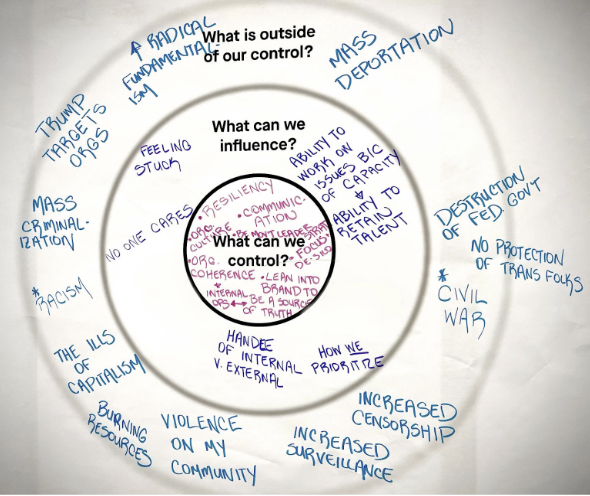This is a love letter to our clients and friends working in the Democratic campaign (and campaign-adjacent) world right now. It’s a 2-parter: Solid Practices for Stressed Teams is also a snapshot of what we’re seeing and doing, in real time, with clients who are working hard to navigate stress and, you know, preserve democracy.
We know you’re holding a lot. You’re operating in an environment where everyone around you is keenly aware and constantly reminding you (in loud, urgent screams) of what’s at stake in November’s elections. Truth is co-opted and twisted. Democracy is on the line. We are, as a society, proving completely unable to balance multiple perspectives and experiences. And, while all of that is happening, you’re also managing complex teams, many of which include folks just entering the workforce.
In our conversations with individuals and teams in movement spaces over the past six months, we’ve found ourselves coming back, again and again, to the importance of managing energy via Stephen Covey’s circles of concern, influence, and control. The premise is straightforward, and grounded in three key questions:
What is outside of our control? The outermost in the series of three concentric circles, the Circle of Concern encompasses everything we care about — issues and situations that affect us — but over which we have no direct control. Within our circle of concern right now might be the ever-rising death toll of the Palestinian people in Gaza and the West Bank, climate change amidst hurricane season, and the general disbelief and disinterest in news and truth.
What can we influence? The middle circle is the Circle of Influence. It exists inside the Circle of Concern, and it encompasses the areas we can actually affect through our actions. These are things we can impact through our direct behavior and choices, such as our relationships, personal habits, and work environment.
What can we control? The innermost circle is the Circle of Control. This is the smallest circle and lies within the Circle of Influence. It includes things over which we have direct control, primarily our own thoughts, actions, and reactions.
Covey and his team think and write about being proactive. Here’s the roadmap we take our clients (both individually and in teams) through to adopt a proactive posture, along with highlights from a real-life team session.
Step 1: Put Feelings on the Table
Feelings. We’ve all got them, and when we’re stressed we tend toward negative, or difficult to manage, emotions. Naming feelings, both for ourselves and out loud, is foundational to building emotional intelligence. Naming feelings increases self-awareness, helps us be seen by others, and creates space to more effectively regulate and co-regulate. It is key to building resilience in ourselves, and to building empathy and connection with the folks around us.
Over the last few months, we’ve facilitated the leadership team of a large and critically important nonprofit through a series of scenario planning sessions to prepare for a potential Trump win. It’s everyone’s worst nightmare, and we knew we needed to deal with both the very real trauma of 2016 and the impending doom that scenario presents today.
We asked folks to name the feelings emerging as they considered this scenario, and we used Mentimeter to collect responses. Participants witnessed each other’s feelings — they noticed what folks wrote, where folks were, how folks experienced feeling through the scenario of a Trump win. We held time and space for participants to notice their own feelings in response to each other’s feelings, to see and hear, and also to be silent.
Here’s where that group landed:
Step 2: Articulate (Biggest) Fears
Remember how, as a kid, the fastest way to get back to sleep after a nightmare was to tell someone what you dreamt? (Shoutout to our currently parenting readers who do this now.) We follow the same premise with teams. Articulating fears, and their deepest consequences, can provide emotional relief. It can help us normalize, gain perspective, and sometimes even give us a sense of agency.
Back to our big leadership team tackling a scenario in which Trump wins the presidential election. We asked them to name their biggest fears and the possible impact:
“I’m afraid of …”
“If my worst fears materialize, it will mean … is happening.”
Folks spent 5 minutes in full release mode, and then things got pretty dark. We shared. It was ugly. There were long, quiet pauses. Lots of deep breaths.
Step 3: Sort Fears Across Circles of Concern, Influence, and Control
Now the fun part. We’ve released our feelings into the world. We’ve articulated the absolute scariest stuff, the worst-case scenarios, the full manifestation of our fears. What’s left? Figuring out what we can do with all these feelings and fears.
We asked the leadership team to sort out all the fears they identified into three buckets: What is outside of our control? What can we influence? What can we control?
Beginning with the outer layer, we asked folks to name the things they’re concerned about that they felt are completely outside their control. Next, we moved into naming the things they can influence. And, finally, we heard folks articulate their thoughts on what they can directly control.
Here’s how it looked on paper:
From here, teams can begin moving toward action on the things they can control and influence. The team with whom we worked went off to build plans that they’ll be ready to execute in the coming months and in the months following the election, regardless of the outcome. They’re operating in proactive ways, and it’s making space for folks to both feel their feelings and to keep moving forward.
Could your team benefit from this kind of exercise? We’re ready to help. Let’s have a conversation about how we can supporting your team.


